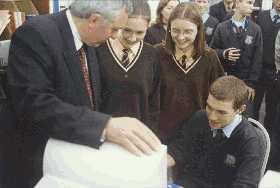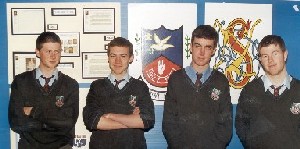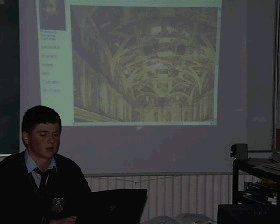A project proposal was submitted to the National Centre for Technology in Education (NCTE) in January 1998 (O’Neill 1998a). Within the project there was an implicit understanding of the importance of collaborative work. This can be seen in the steps taken to seek the support of the School of Computer Applications at Dublin City University (DCU) and from the Education Trust in DCU (O’Neill et al 1998). The Setanta Project was developed with the belief that the provision of hardware and software was a necessary but not sufficient condition for the integration of information and communications technologies into the life of the school. The project set out to examine the question ‘How can we provide equitable and effective access to information and communications technologies within our school?’
|
||||||
DCU Virtual Art Gallery This was accomplished by obtaining the support of faculty and students from the university along with teachers and students from the school. Two faculty members of the School of Computer Applications joined the steering committee for the project and joined in the day-to-day running of the project working with their own students and with school staff and students. They placed an Intranet based project, which had the potential to support Setanta, on the list of third year projects for Computer Applications students. Two students selected this project and undertook to work with their own university supervisors and with teachers and students from St Aidans in producing a Virtual Art Gallery (VAM) for the school Intranet (Farren 2001). St Aidans Gallery At the same time in St Aidans, a group of students undertook to develop their own version of the art gallery. This work was undertaken in co-operation with their art teacher and ICT teacher. As part of this project the students identified their lack of web development skills. A training course in web design skills was set up to meet their own identified needs. While the focus of this course was teaching ICT skills interconnectivity was a key theme. The course was taught by a member of the School of Computer faculty. The class group was made up of fourteen students and four teachers including the principal learning within a classroom as equals on a collaborative venture.
Presenting the achievements of the Setanta projectIn May 2000 the work of the Setanta project was presented to the school community, the university community, the local community and a range of dignitaries including the Taoiseach (Prime Minister), officials from the Department of Education and Science, representatives of the National Centre for Technology in Education (NCTE) and many others. At the event, students demonstrated and explained the work that they had achieved and the learning that they had undertaken. The event gave learners – students and teachers – an opportunity to celebrate their achievements and to gain public recognition for their learning. Within this event the voices of children, which have been missing from the discussion (Kozol 1991) were found and celebrated. The students had been active with their teachers in educational reform. The teachers in this project had sought to make a difference for good with, not for, students (Corbett and Wilson 1995).
|
Reconceptualising teaching and learningHaving deployed their Art gallery to the school Intranet two students undertook teaching a topic in Art history to an Art class. To do this they setup the technology – computer, data projector, intranet access – in the Art room. They prepared a class on Renaissance Art and taught it to a senior Art class. They supported other students in their learning by providing them with information on how to access the web site that they had created. This is a step in making their work public. The students were seen by their peers in a position of authority not usually seen within school. The teachers involved were using their power in an attempt to help others exercise power (Ellsworth 1992: 107). Students and teachers were in the ‘being’ mode of relatedness to the world. Instead of being passive receptacles of words and ideas they listen, they hear, and most important they respond in an active and productive way (Fromm 1979: 38). While developing the Art History web site students worked closely with their Art teacher, and their computer teacher. The nature of the working relationship was collaborative. Each member made their own contribution to the group. Sonya, the Art teacher, offered her knowledge of art history, Ray his knowledge of web development. The students, Niall, David, Stephen John and Aiser brought their personal creativity and enthusiasm to the work. Weekly meetings took place between the members of the group. Within these meetings the key decisions were made on the design and content of the web site. In traditional schools teachers tends to work alone (Lortie, 1975). In learning enriched schools (Rosenholtz 1989) teachers work more together and by having colleagues who show support and communicate more, teachers gain confidence around what they are trying to achieve. ‘Joint work’ – which includes activities like team-teaching, planning and action research – creates stronger interdependence, shared responsibility, collective commitment and improvement (Little 1990: 22). The shared learning gives students an opportunity to engage in discussion, take responsibility for their own learning, and thus become critical thinkers (Totten, Sills, Digby, & Russ, 1991).ng for practice There is persuasive evidence that cooperative teams achieve at higher levels of thought and retain information longer than learners who work quietly as individuals (Johnson and Johnson 1986: 31-2). The collaborative nature of the work promotes meaningful engaged learning (Jones et al. 1994). Conversely engaged learning involves being collaborative – that is, valuing and having the skills to work with others. Successful, engaged learners are responsible for their own learning – they select the content and skills that they wish to learn. Such learners are self-organising and self-regulated and are able to define their own learning goals and evaluate their own achievement. Innovative clustersResearch elsewhere indicates that a key characteristic of innovation is its tendency to cluster (Brown and Duguid 2002: 430). It is argued that innovation clusters because innovative people tend to cluster, staying close to close to those who share their vision, understand their insights and advance their ideas. The innovative collaboration between school and university was part of a process of supporting innovation by surrounding oneself by innovative people Within the Setanta project support for innovative practice was found locally, with innovative colleagues in school, in the university and in NCTE. Evidence from the Launch of the Setanta ProjectEvidence from the SIP Symposium |






